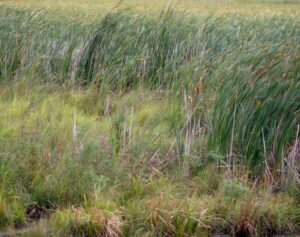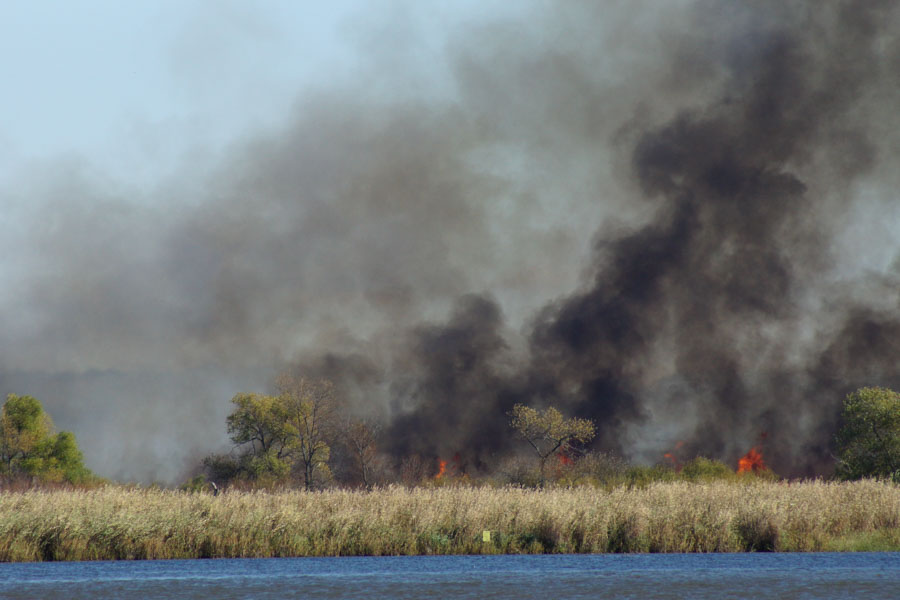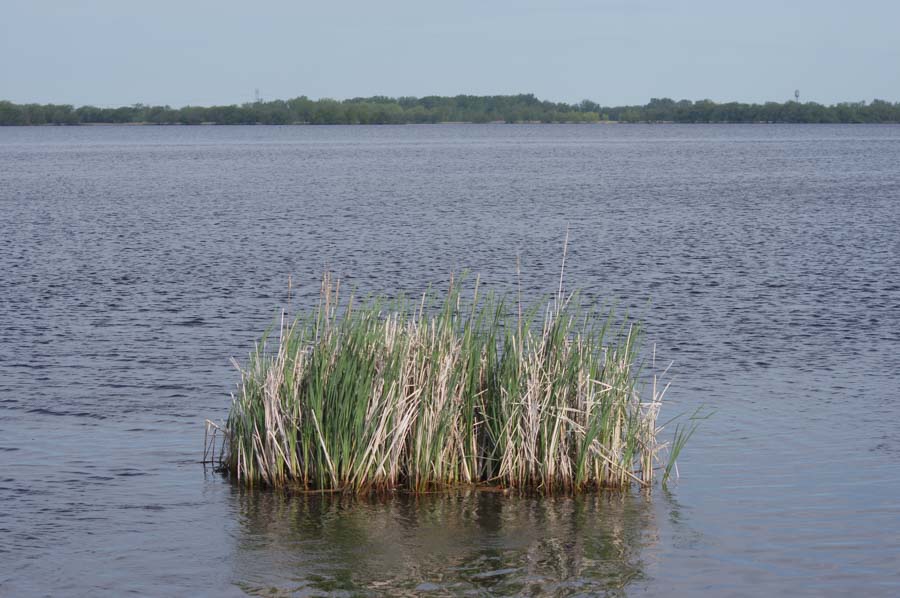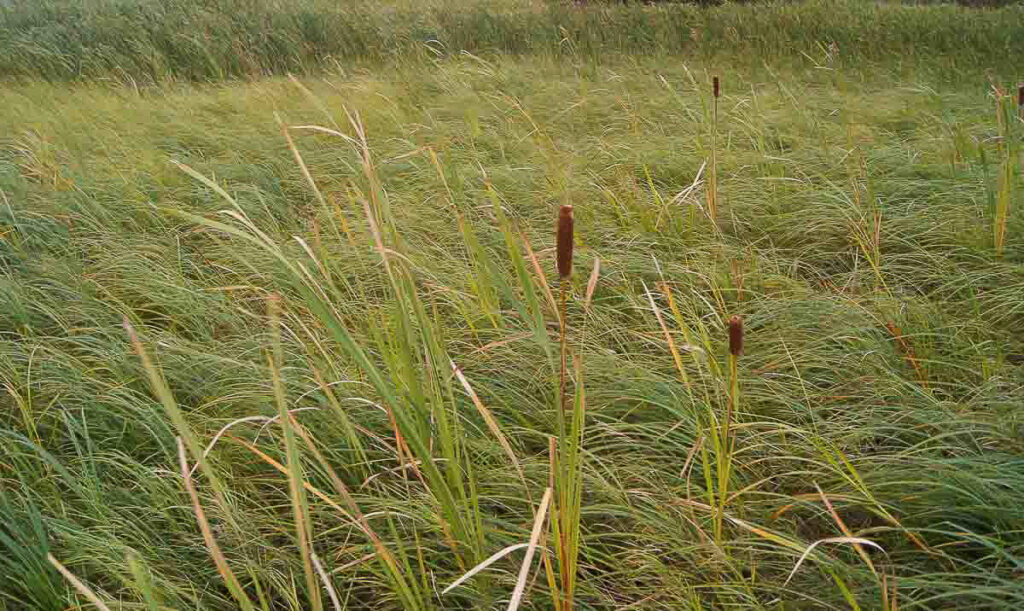Invasive Cattail Species:
Narrowleaf Cattail (Typha angustifolia)
Hybrid Cattail (Typha x glauca)

Other names: Often called bulrushes in the United Kingdom and some other localities, but in the states bulrushes are usually in the sedge family. Plant Family: Typhaceae Wetland Indicator Status OBL
History
Cattails have been a part of wetlands in the United States and Canada for since before the last ice age. The northern half of the US and much of Canada was home to one species of Cattail, Broadleaf Cattail (Common Cattail). That changed sometime in the nineteenth century, perhaps before, when Narrowleaf Cattail was introduced. The cause of the introduction is not known, but it was likely caused by the activity of humans. The minute seeds of all cattail seeds are easily transported by many different routes. Narrowleaf Cattail began to spread west from the Eastern coast of the United States, and at some point hybridized with Broadleaf Cattail (Typha latifolia), forming Hybrid Cattail (T. x glauca).

Identification of Invasive Cattails and Confusion with Native Cattail
Whether or not Narrowleaf cattail is native or not has been debated for decades, but it is now generally accepted by researches that it is not native to North American. However far too plant identification books list Narrowleaf cattail as native, and do not acknowledge the existence of hybrid cattail. Unfortunately this misinformation continually gets passed on and many natural resource professionals and even scientists do not realize this mistake. Furthermore it is a major problem when these professionals and the general public look upon hundreds or thousands of acres of cattail marsh and think it natural. In all cases I am aware of, the dense stands of cattails are all invaders that have replaced entire native ecosystems. This is the equivalent of replacing native prairie with alfalfa. The plant community population is forever changed, along with this change in plants, so follow wildlife, fish, hydrology and the flow of nutrients. Without knowledge of this destruction of native habitat nothing can be done to stop, slow or reverse the advance of invasive cattails. Because hybrid cattail can backcross with either parent identification can be difficult, but a general rule of thumb can be applied, and that is the gap between male and female flowers. If there is large one larger than a centimeter the great likelihood is it is invasive if there is no gap or the gap is only a few millimeters than it is more than likely to be broadleaf cattail. If the cattails are growing in a group look at several flower spikes if available. The gap between flowers is not visible at all times of the year, and obviously not on sterile plants. To some extent the width of the leaves can be used, but one can also look at the behavior, are the plants behaving like an aggressive, invasive species? Flower Gaps (Crow and Hellquist 2000)
- Broadleaf Cattail usually 0, sometimes 5mm
- Narrowleaf Cattail 1-8 cm
- Hybrid Cattail 0.5 – 4 cm
Leaf Widths
- Broadleaf Cattail
- Narrowleaf Cattail 3-8mm
- Hybrid Cattail 6-15 mm
Cattail Control
Invasive Cattails are very hard to control once firmly established. True eradication is rarely accomplished, and only by extreme means such as the removal of the top layer of wetland soil that removes the roots and cattail seedbank. However there are several other management practices that can reduce cattail abundance, or stop the spread.
Herbicide
Early invasion of cattails in a wetland can be quite effective by spot treating new clones before they become large and grow together with others. If small enough this can be done with backpack sprayers. Herbicide such as Rodeo eliminates all vegetation, but native seeds in the soil will generate and replace the cattails. However, there will be cattail seeds there too and the area will have to be monitored for regrowth of cattails. Over large areas the preferred means of cattail control is aerial spraying. Many acres of wetland can be covered in a short amount of time. The logistics of getting heavy sprayers into infected areas is limited as is the physical damage trucks and trackers can leave.
Water level management
Cattails require oxygen to their roots and continual flooding stresses plants, particularly when the leaves and stems are cut below the waterline in winter. Stems crushed with rollers also serve the same function as cutting. Flooding also attracts muskrats, which consume the plants and use all parts of the plants to construct there lodges. If muskrats are allowed to reproduce unchecked they can eat up a cattail marsh in a few years. Not all marshes have water control structures, and it is not always socially acceptable to flood a marsh, so this management strategy is not always an option.
Cutting, crushing and grazing cattails
One of the major ways cattails come to take over native vegetation is they are much taller than all native vegetation except Common Reed (Phragmites australis) Therefore they can shade out native plants. They also produce massive amounts of leaf litter, which acts as a mulch, smothering native plants. By cutting, crushing the stems and leaves it reduces the shading effect. Grazing livestock in wetland also has this same effect, but is controversial. It is much more effective if the leaf litter is then removed, and most effective if done when the cattails are green in late summer before they send extra nutrients back to the roots before next year’s growth. Cattails can never be eliminated in this way, but it levels the playing field for native species of plants and creates something of a balance between native and non-native. This is not a onetime event, it must be done frequently. If the practice is abandoned, the invasive cattails will once again take over the wetland. Logistical problems with cutting and removal are many. On very small applications such as a roadside ditch many of the logistics are easily overcome, but on large scales it is much more difficult. The soggy nature of wetland soils and the frequent occurrence of floating mats of vegetation or potholes can make travel with heavy machinery impossible. Lightweight cutters such as walk-behind tractors, or floating ATVs like the Argo are good for cutting small to moderate areas, but the logistics of removing the heavy leaves is still there. It would be best to bundle up the leaves and stems and then remove them when wetlands freeze. This is not an option in more southern wetlands, and wetlands do not always freeze solid enough annually.
Fire

Fire in wetlands is part of the natural process of wetland renewal and has always occurred in wetlands, during annual dry periods, or during droughts. Wetlands rely on the burning of organic matter to reduce the natural succession of grass and sedge wetlands to shrub and forested ones. In the management of cattails, fire has two major effects. The first is fire maintains a healthy native wetland, and a healthy wetland is less susceptible to invasion by Cattails and other non-native species. The second is like cutting and removal of stems it reduces the shading and mulching effect of cattails. If done before winter it reduces the ability of cattails to get oxygen to their roots, this effect is greatly magnified if the wetland if then flooded before freeze-up. This causes major stress to the plants and can kill many of them, or again at least levels the playing field for native species. Fire is a controversial practice and comes with a host of new logistical problems. The smoke created by fire is very high in particulate matter and can cause short-term air pollution problems, as shown in the video below. The ash left behind can easily be washed into surface water, adding nutrients that feed algae. Fire can escape to uplands if not carefully managed, damaging property and threatening homes. Despite these problems, fire is one of the quickest means of managing cattails on a large scale. It is the only cost-effective way of removing decades of leaf litter.
Prescribed Burn at Uihlein Waterfowl Production Area
Wildlife and fisheries impacts of Cattail Control
In the long-term cattail management will benefit dozens of species of birds mammals and fish, but in the short term in can destroy nesting and other habitats. It is best to leave at least one portion of marsh untreated annually to provide nesting cover for birds and spawning sites for fish. However, this may not always be practical and it is more important to have good habitat for years to come rather than it be permanently degraded.
Conclusion
Management of dense stand-forming invasive species such as Narrowleaf, and Hybrid Cattails should be the top concerns of wetland management where ever they occur. No other threat, in my opinion, is as great to native wetlands in many areas. Loss of wetlands has been greatly reduced thanks to legislation and voluntary practices, but degrading of wetlands, by aggressive non-native plants like reed canary grass, invasive phragmites, and these cattails is a major problem. If our remaining marshes and meadows are allowed to be converted into rather sterile cattail marshes then, what we have will be better than a cornfield, slightly better than alfalfa, but not a great deal. Unfortunately management of cattails is rarely inexpensive or without controversy. Only by educating the public on the importance of native wetlands, and what cattail invasion does to native wetlands, can we sufficiently tackle this problem.
Human and Wildlife Use of Cattails
Cattail species are all similar in their usefulness, but the incredible densities that invasive cattails grow makes them a more economical source for industrial purposes. This is explored on the Broadleaf Cattail page.
Cattail links
Treatment on the Cattail Family: Flora of North America: Typhaceae
Cattail Resources
Crow, G. E. and Hellquist C. B. 2000 Aquatic and Wetland Plants of Northeastern North America Vol 2. University of Wisconsin Press. Madison


